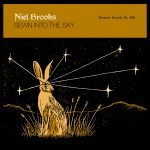Who says you can’t make a gorgeous “dark night of the soul” album that’s largely without vocals? That’s what our friend Niel Brooks has done with his new album, Sewn Into The Sky.
With his intricate acoustic guitar playing and unerring sense of mood, the melodies unwind gently, moving down unexpected paths but never straying too far from the evocative motifs that pull you into the middle of his world. You’ll hear echoes of artists like Neil Young or Jackson Browne on the handful of vocal tracks, and a lot of Mississippi John Hurt and John Fahey in his guitar playing, but this is ultimately all Niel and all excellent. Here’s some musings from the man himself on making this record.
“It was late October, and I was fighting a terrible head cold and medicated to within a hair of a coma. I was sitting on my front porch, tuning my guitar to what I thought might be something inspiring, and for the next two hours fumbled around to find I’d been tuned to David Crosby’s “Guinnevere”. That’s not so strange, really. I’ve listened to that song since I was a baby and my dad would play the Crosby, Stills, And Nash album. What I found, though, was a wide open ocean of undiscovered (at least to me) voicings and harmonies that would later become “Narmie And Rosie”.
Narmie and Rosie were two lovely cats, owned by my friend, Cara, for nearly fifteen years. When Narmie passed away, it wasn’t long until Rosie joined. A matter of days, really. This is the only song on the record with two guitars: a six and twelve string. They come in and out of unison, play harmonies with each other, and bow out intermittently. There is also a bit of reverse echo on the recording: something I’ve always thought was an interesting sound on some of Jimmy Page’s recordings. In a roundabout way, that type of reverb is the future preceding the present. The way it’s done, and hopefully I won’t bore many people, is to record an echo with the track, then reverse the tape and line up the echo swell with the beginning of the note that produced the echo – Past to Present. In use, it sort of sounds like swell of sound, ending with a pure tone of guitar. It’s kind of like how things sound when I’m dreaming. I might be dreaming that I’m in the woods, and I hear a train in the distance, but there’s no up and down doppler effect, so I can’t tell where the sound is coming from.
After I’d written the main parts of “Narmie And Rosie”, I set up in my small recording space to put it down on tape. And from there, the rest of the album came right out. There are two microphones, a tape machine, and some reverb here. Each song has larger meanings to me, but would no doubt change the listener’s perspective if I were to delve into them in detail. So here’s just a few things I thought listeners might want to know.
Lisa Stubbs (Mourning Dove) sings harmony on the track “The Angels Laid Him Away/Louis Collins”. This song was written by Mississippi John Hurt. Hurt originally recorded the song in 1928, for OKeh Records. It’s one the finest examples that I know of in the American murder ballad catalog, and certainly a song that many songwriters have looked to for inspiration. Whether “Bob shot first”, or not, isn’t the point. It’s the moaning loss and despair by Louis’ mother that really resonates through the song. And in a climate like today, where many news organizations try to search for reasons to blame victims, this song is still pertinent. A mother has lost her child, and that’s what we know. It’s all too confusing, too common, and a little too real.
“What Happened On Saco River Road” is simply a Piedmont Blues that I wrote about a hidden little road located in the “dark corner” of South Carolina. This mysterious area of the foothills and mountains, just at the border of North and South Carolina, was home to much of the illegal moonshine-stills during Prohibition. There are lots – and lots – of hidden, forgotten, and buried (whether on purpose or by the natural erosion of the particular geographic location) homes, stills, and paths in these hills. They all hold the secrets of their past close to the earth. When the revenuers came through the area, searching to bust the moonshiners, more often than not, those revenuers never returned home. Also sprinkled among those old worn stills are the remnants of family graveyards, enormous muscadine patches, thousands of waterfalls, and just about every kind of kudzu. It’s not hard to find old stone arrow heads and other buried oddities throughout the area… nor is it usually hard to find the remnants of a recent beer party from local teenagers. It’s all amazing, like walking through an uncurated museum of American history.
This record was made over a few days in late Autumn, and I hope that feeling comes through. If you listen to the song, “Sewn Into The Sky”, using headphones, you can hear the rain storm outside. No studio trickery here to get rid of outside sounds. All of my foot tapping is genuine and I honestly wouldn’t have it any other way.













